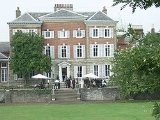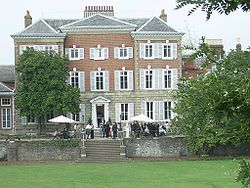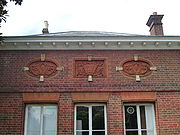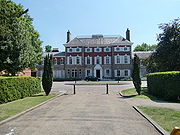
York House, Twickenham
Encyclopedia

Twickenham
Twickenham is a large suburban town southwest of central London. It is the administrative headquarters of the London Borough of Richmond upon Thames and one of the locally important district centres identified in the London Plan...
, England
England
England is a country that is part of the United Kingdom. It shares land borders with Scotland to the north and Wales to the west; the Irish Sea is to the north west, the Celtic Sea to the south west, with the North Sea to the east and the English Channel to the south separating it from continental...
, and currently serves as the Town Hall of the London Borough of Richmond upon Thames
London Borough of Richmond upon Thames
The London Borough of Richmond upon Thames is a London borough in South West London, UK, which forms part of Outer London. It is unique because it is the only London borough situated both north and south of the River Thames.-Settlement:...
. It is situated in Richmond Road, near the centre of Twickenham, close to St Mary’s Church.
History
Unlike several other UK buildings also called York House, the Twickenham building did not take its name from being a residence of a Duke of YorkDuke of York
The Duke of York is a title of nobility in the British peerage. Since the 15th century, it has, when granted, usually been given to the second son of the British monarch. The title has been created a remarkable eleven times, eight as "Duke of York" and three as the double-barreled "Duke of York and...
. The central portion of York House dates to the 1630s and derives its name from the Yorke family, owners of farming land in the area. It was built for Andrew Pitcarne, a courtier of King Charles I
Charles I of England
Charles I was King of England, King of Scotland, and King of Ireland from 27 March 1625 until his execution in 1649. Charles engaged in a struggle for power with the Parliament of England, attempting to obtain royal revenue whilst Parliament sought to curb his Royal prerogative which Charles...
. When Pitcarne died in 1640, the house was sold to Edward Montagu, 2nd Earl of Manchester
Edward Montagu, 2nd Earl of Manchester
Edward Montagu, 2nd Earl of Manchester KG, KB, FRS was an important commander of Parliamentary forces in the First English Civil War, and for a time Oliver Cromwell's superior.-Life:...
in 1656, and then re-sold in 1661 for £3,500 to Henry Hyde
Henry Hyde, 2nd Earl of Clarendon
Henry Hyde 2nd Earl of Clarendon PC was an English aristocrat and politician. He held high office at the beginning of the reign of James II of England, who had married his sister.-Early life:...
, the son of Edward Hyde, 1st Earl of Clarendon
Edward Hyde, 1st Earl of Clarendon
Edward Hyde, 1st Earl of Clarendon was an English historian and statesman, and grandfather of two English monarchs, Mary II and Queen Anne.-Early life:...
, the Lord Chancellor
Lord Chancellor
The Lord High Chancellor of Great Britain, or Lord Chancellor, is a senior and important functionary in the government of the United Kingdom. He is the second highest ranking of the Great Officers of State, ranking only after the Lord High Steward. The Lord Chancellor is appointed by the Sovereign...
.
It then passed through several owners, including (in the late 18th century) Count Ludwig von Starhemberg (1762–1833), the Austria
Austria
Austria , officially the Republic of Austria , is a landlocked country of roughly 8.4 million people in Central Europe. It is bordered by the Czech Republic and Germany to the north, Slovakia and Hungary to the east, Slovenia and Italy to the south, and Switzerland and Liechtenstein to the...
n ambassador to London
London
London is the capital city of :England and the :United Kingdom, the largest metropolitan area in the United Kingdom, and the largest urban zone in the European Union by most measures. Located on the River Thames, London has been a major settlement for two millennia, its history going back to its...
. He accumulated debt and in 1817 the house was sold to Mrs Anne Seymour Damer
Anne Seymour Damer
Anne Seymour Damer, née Conway, was an English sculptor.-Life:Anne Conway was born into an aristocratic Whig family, the only daughter of Field-Marshal Henry Seymour Conway and his wife Caroline Bruce, born Campbell, Lady Ailesbury , and was brought up at the family home at Park Place, Remenham,...
(1748–1828), a sculptress and close friend of Horace Walpole, after whom the house passed to linguist
Linguistics
Linguistics is the scientific study of human language. Linguistics can be broadly broken into three categories or subfields of study: language form, language meaning, and language in context....
Sir Alexander Johnstone (1775–1849), a former Chief Justice of Ceylon
Sri Lanka
Sri Lanka, officially the Democratic Socialist Republic of Sri Lanka is a country off the southern coast of the Indian subcontinent. Known until 1972 as Ceylon , Sri Lanka is an island surrounded by the Indian Ocean, the Gulf of Mannar and the Palk Strait, and lies in the vicinity of India and the...
, founder of the Royal Asiatic Society
Royal Asiatic Society
The Royal Asiatic Society of Great Britain and Ireland was established, according to its Royal Charter of 11 August 1824, to further "the investigation of subjects connected with and for the encouragement of science, literature and the arts in relation to Asia." From its incorporation the Society...
and a Privy Councillor. Members of the Johnstone family continued to live in the house until 1863, intermixed with tenants such as the Dowager
Dowager
A dowager is a widow who holds a title or property, or dower, derived from her deceased husband. As an adjective, "Dowager" usually appears in association with monarchical and aristocratic titles....
Duchess of Roxburghe (widow of the 5th Duke
James Innes-Ker, 5th Duke of Roxburghe
James Innes-Ker, 5th Duke of Roxburghe was a Scottish nobleman.He was the eldest surviving son of Sir Henry Innes, 5th Baronet , and Anne Drummonda Grant . He succeeded to the Baronetcy on his father's death...
) until 1837, and William Lowther, 1st Earl of Lonsdale
William Lowther, 1st Earl of Lonsdale
William Lowther, 1st Earl of Lonsdale of the second creation KG was a British Tory politician and nobleman.-Life:...
(1757–1844).

House of Orleans
Orléans is the name used by several branches of the Royal House of France, all descended in the legitimate male line from the dynasty's founder, Hugh Capet. It became a tradition during France's ancien régime for the duchy of Orléans to be granted as an appanage to a younger son of the king...
Pretender, Philippe, comte de Paris
Philippe, Comte de Paris
Philippe d'Orléans, Count of Paris was the grandson of Louis Philippe I, King of the French. He was a claimant to the French throne from 1848 until his death.-Early life:...
. Three of his four children were born in York House. He and his family returned to France following the defeat and fall of Napoleon III
Napoleon III of France
Louis-Napoléon Bonaparte was the President of the French Second Republic and as Napoleon III, the ruler of the Second French Empire. He was the nephew and heir of Napoleon I, christened as Charles Louis Napoléon Bonaparte...
as a result of the Franco-Prussian War
Franco-Prussian War
The Franco-Prussian War or Franco-German War, often referred to in France as the 1870 War was a conflict between the Second French Empire and the Kingdom of Prussia. Prussia was aided by the North German Confederation, of which it was a member, and the South German states of Baden, Württemberg and...
of 1869-71.
The house then remained empty until 1876 when it was bought by Sir Mountstuart Elphinstone Grant Duff
Mountstuart Elphinstone Grant Duff
Sir Mountstuart Elphinstone Grant Duff GCSI, CIE, PC FRS , known as M. E. Grant Duff before 1887 and as Sir Mountstuart Grant Duff thereafter, was a Scottish politician, administrator and author...
(1829–1906), a Scottish MP, junior minister in Gladstone
William Ewart Gladstone
William Ewart Gladstone FRS FSS was a British Liberal statesman. In a career lasting over sixty years, he served as Prime Minister four separate times , more than any other person. Gladstone was also Britain's oldest Prime Minister, 84 years old when he resigned for the last time...
's first government, and from 1881 to 1887 Governor of Madras. A notable guest, Laurence Oliphant, died at York House on 23 December 1888.
The link with the Orleanists was renewed for a decade from 1896 to 1906 when the then Orleanist pretender Philippe, duc d'Orléans reacquired the house he'd been born in.
Sir Ratan Tata

India
India , officially the Republic of India , is a country in South Asia. It is the seventh-largest country by geographical area, the second-most populous country with over 1.2 billion people, and the most populous democracy in the world...
. After acquiring the house in 1906 he had the riverside section of the gardens largely laid to lawn as an Italian style garden; which was a setting for garden parties and to show off a set of statues
The Naked Ladies
The Naked Ladies are a statue complex on a rockery and water cascade in the gardens of York House, Twickenham, Middlesex, England. The larger than human size statues depict eight Oceanids and a pair of aquatic horses. They were carved in the fin de siècle style from white Carrara marble and...
that he'd bought. A generous donor to charities, he entertained widely until 1914, when he returned to India. In 1917, on his way back to England, his ship was sunk in the Mediterranean. Now a sick man, he survived, only to die in 1918. His widow decided to sell the house and its contents in 1924.
Twickenham Council

Municipal Borough of Twickenham
Twickenham was a local government district in Middlesex, England from 1868 to 1965.Twickenham Local Government District was formed in 1868, when the civil parish of Twickenham adopted the Local Government Act 1858. The district was governed by a local board of 27 members.The Local Government Act...
and after major alterations became the council's offices. The new council chamber was formally opened by the then Duke of York (later King George VI
George VI of the United Kingdom
George VI was King of the United Kingdom and the Dominions of the British Commonwealth from 11 December 1936 until his death...
) in 1926, the same year the urban district became a municipal borough.
Since 1965 York House has been the municipal offices of the Richmond upon Thames London Borough Council
London Borough of Richmond upon Thames
The London Borough of Richmond upon Thames is a London borough in South West London, UK, which forms part of Outer London. It is unique because it is the only London borough situated both north and south of the River Thames.-Settlement:...
, housing the mayor's parlour, staff social club, council chamber, committee rooms and two public halls. By 1990 most of the council staff had been transferred to a new civic centre next door, allowing major restoration and renovation work to be carried out in York House.
The Gardens
The front gardens are largely a public car park and tennis courts. The rear gardens are bisected by a public road but run to the River ThamesRiver Thames
The River Thames flows through southern England. It is the longest river entirely in England and the second longest in the United Kingdom. While it is best known because its lower reaches flow through central London, the river flows alongside several other towns and cities, including Oxford,...
and are open to the public, with the sunken lawn sometimes used for open-air theatre in the summer. A stone footbridge connects the two halves of the gardens.
The Riverside gardens contain a Cut Leaf Beech that has been designated one of the "Great Trees of London".
York House is a popular venue for weddings and other functions, also having on-site catering and a licensed bar available for hire.

